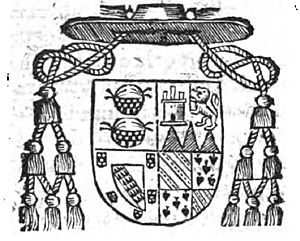Pedro Pacheco de Villena facts for kids
Pedro Pacheco de Villena (born June 29, 1488 – died March 5, 1560) was an important Spanish church leader. He was also known as Pedro Pacheco Ladrón de Guevara. He became a cardinal and even served as the viceroy of Naples, which meant he governed Naples for the king. His nephew, Francisco Pacheco de Toledo, also became a cardinal.
Contents
Pedro Pacheco's Early Life and Education
Pedro Pacheco de Villena was born into a noble family. His father was Alfonso Tellez Giron. Pedro studied at the famous University of Salamanca in Spain. After his studies, he moved to Rome in 1522. There, he worked closely with Pope Alexander VI, acting as a special assistant.
Working for the Pope
Pedro Pacheco held several important jobs within the Roman Curia, which is like the Pope's main government. One of his roles was a high-ranking legal official at the Supreme Tribunal of the Apostolic Signatura. He also served as the Dean of Santiago Cathedral and Archdeacon of Valpuesta, which are significant positions in the church.
Serving the Emperor
Emperor Charles V recognized Pedro Pacheco's talents. He sent him to inspect government offices in Valladolid and Granada. This showed that Pedro was trusted with important tasks by both the Pope and the Emperor.
Becoming a Bishop
Pedro Pacheco's career in the church grew steadily.
Bishop of Mondoñedo and Ciudad Rodrigo
On September 6, 1532, Pope Paul III made him the bishop of Mondoñedo in Galicia, Spain. Later, on April 11, 1537, he was moved to lead the church area of bishop of Ciudad Rodrigo.
Bishop of Pamplona
The Emperor then appointed him bishop of Pamplona. Pope Paul III confirmed this on May 21, 1539. Pedro Pacheco officially took charge of his new diocese in March 1540. He worked to improve how the church in Pamplona was run. In August 1544, he called a special meeting for his diocese, known as a synod. He also started the tradition of holding annual processions for important religious holidays like Corpus Christi and Easter.
Bishop of Jaén and Sigüenza
The Emperor wanted Pedro Pacheco to represent him at the Pope's court in Rome. To give him the necessary status and money for this important job, the Emperor appointed him bishop of Jaén. Pedro Pacheco then appointed a vicar to manage the diocese in his place while he was in Rome. Later, on April 30, 1554, he became the bishop of Sigüenza, a position he held until his death.
Cardinal and Viceroy
Pedro Pacheco's influence continued to grow.
Becoming a Cardinal
Pope Paul III recognized Pedro Pacheco's dedication and made him a cardinal on December 16, 1545. This is a very high honor in the Catholic Church.
Role at the Council of Trent
Cardinal Pacheco was an important participant in the Council of Trent. This was a very significant meeting of church leaders that aimed to reform the Catholic Church. He was the first to discuss the idea of the Immaculate Conception of the Virgin Mary at this council.
Papal Elections (Conclaves)
Cardinals participate in special meetings called conclaves to elect a new Pope. Cardinal Pacheco took part in the conclave of 1549–50, which elected Pope Julius III. He also attended the second conclave of 1555, where Pope Paul IV was chosen. He did not attend the first conclave of 1555.
Viceroy of Naples
In 1553, Emperor Charles V appointed Cardinal Pacheco as the viceroy of Naples. This meant he was the chief governor of Naples, representing the Emperor. He served in this role until 1555.
Later Years and Death
In 1557, he became a Cardinal Bishop, taking charge of the See of Albano. Sadly, this area was badly affected by wars during his time there. He also participated in the conclave of 1559, which elected Pope Pius IV. In the same year, Pope Pius IV made him one of the six Cardinal Inquisitors for the Roman Inquisition, a special court of the church.
Pedro Pacheco de Villena died suddenly in Rome on March 5, 1560. He was first buried in Rome, but his body was later moved to the Convent of the Franciscans in Puebla de Montalban, Spain, a place he had helped to establish.
Sources
- Angel Martín González, El cardenal don Pedro Pacheco, obispo de Jaén, en el Concilio de Trento : (un prelado que personificó la política imperial de Carlos V) (Jaén : Instituto de Estudios Giennenses, Excma. Diputación Provincial, 1974).
See also
 In Spanish: Pedro Pacheco de Villena para niños
In Spanish: Pedro Pacheco de Villena para niños



